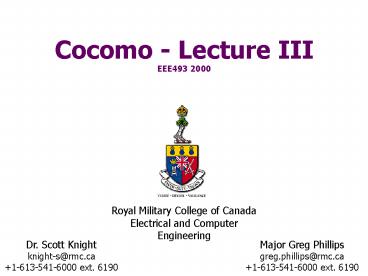Cocomo Lecture III EEE493 2000 - PowerPoint PPT Presentation
1 / 21
Title:
Cocomo Lecture III EEE493 2000
Description:
What are the three modes of development under Basic COCOMO? ... For $10,000 Megabit could by 96K words of main memory vs. the current 64K ... – PowerPoint PPT presentation
Number of Views:25
Avg rating:3.0/5.0
Title: Cocomo Lecture III EEE493 2000
1
Cocomo - Lecture III EEE493 2000
Royal Military College of Canada Electrical and
Computer Engineering
- Major Greg Phillips
- greg.phillips_at_rmc.ca
- 1-613-541-6000 ext. 6190
Dr. Scott Knight knight-s_at_rmc.ca 1-613-541-6000
ext. 6190
2
Refs
- Pressman, R.S., Software Engineering a
Practitioners Approach 5th Ed., McGraw-Hill,
2001, Chapter 4 - Boehm, Barry, Software Engineering Economics,
Prentice-Hall, 1981
3
Teaching Points
- Maintenance using the Intermediate Model
- Sensitivity/options analysis
4
Review
- What are the three modes of development under
Basic COCOMO? - How does Intermediate COCOMO differ from basic
COCOMO ? - Since we are using a product of the individual
cost driver effort multipliers as the adjustment
factor, what must be a basic assumption about the
cost drivers?
5
Recall A Pricing ExampleMicroprocessor
Communications Software
6
Cost Driver Ratings Microprocessor
Communications Software
7
Project Cost Microprocessor Communications
Software
- PMnom 2.8(10)1.2 44 pm
- PMadj 44 pm ? 1.17 51 pm
- 51 pm ? 6000 /pm 306,000
nominal
adjusted
8
(No Transcript)
9
What if we used less expensive personnel?
- I.e. less capable analysts and programmers
- Remuneration is now 5000/month
- Therefore ACAP and PCAP are now nominal in value
- The effort multipliers are 1.00 vice .86
- Effort Adjustment Factor is now 1.58
- PMadj 44 pm ? 1.58 70 pm
- 70 pm ? 5000 /pm 350,000
- Therefore senior analysts and programmers are
more economical (by 44,000) in this case
10
What if we bought more memory?
- For 10,000 Megabit could by 96K words of main
memory vs. the current 64K - Main storage constraint 45K/96K .47
- Therefore STOR is now nominal
- I.e. STOR 1.00
- Effort Adjustment Factor is now 1.10
- PMadj 44 pm ? 1.10 48 pm
- 48 pm ? 6000 /pm 288,000
- The 18,000 saving offsets the 10,000 expense
11
Options Analysis
- We can use these sensitivity analysis techniques
to cost different development scenarios - This is an optimization problem
- We are trying to minimize the cost-to-complete a
project - But what about the lifecycle cost?
12
Adjusted Annual Maintenance
- Most cost drivers are the same for the
maintenance phase as for the development phase - The exceptions are
- SCED
- RELY
- MODP
13
SCED under maintenance
- SCED is always nominal
- development schedule does not effect maintenance
14
RELY under maintenance
- Consider
- high reliability -gt more effort to reach the
required level of quality - lower reliability -gt less effort to maintain the
required level of quality - lower reliability -gt more effort to fix the
latent faults in the code, docs, etc.
15
MODP under maintenance
- The more MPPs (modern programming practices)
used the greater the savings in maintenance - The more MPPs user the greater the economies in
maintaining larger projects (i.e. the more
success in reducing the diseconomies of scale)
16
Maintenance Example
- Use the example as before of the 10 KDSI
communications product with the 96K main memory
upgrade option - Assumptions
- product will be maintained by nominal programmers
and analysts _at_ 5000/pm - virtual machine volatility will be low vs.
nominal - virtual machine experience will be nominal vs.
low - annual traffic change 20
- nominal development effort was 44 pm
17
Effort Multipliers
18
Maintenance Example (contd)
- PMAM 1.14 ? .20 ? 44 pm 10.0 pm
- FSPAM 8.8 pm/12 months 0.83 fsp
- 10 pm ? 5000/pm 50,000 (yearly)
19
Lifecycle Cost
- Consider a 10 year lifecycle for our
communications software - Assume the example as before with the 96K main
memory upgrade option - Development
- 288,000
- Maintenance
- 50,000/year ? 10 years 500,000
- Lifecycle cost
- 788,000
20
Discussion
- What about the sensitivity to the primary cost
driver? - What about the relevance of the models database?
- Are the cost drivers likely to remain constant
across the phases of the development process?
21
Next ClassConfiguration management































